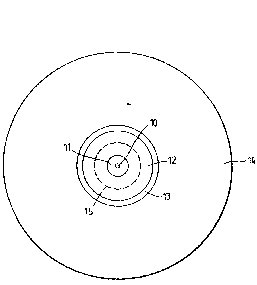Une partie des informations de ce site Web a été fournie par des sources externes. Le gouvernement du Canada n'assume aucune responsabilité concernant la précision, l'actualité ou la fiabilité des informations fournies par les sources externes. Les utilisateurs qui désirent employer cette information devraient consulter directement la source des informations. Le contenu fourni par les sources externes n'est pas assujetti aux exigences sur les langues officielles, la protection des renseignements personnels et l'accessibilité.
L'apparition de différences dans le texte et l'image des Revendications et de l'Abrégé dépend du moment auquel le document est publié. Les textes des Revendications et de l'Abrégé sont affichés :
| (12) Brevet: | (11) CA 2071063 |
|---|---|
| (54) Titre français: | FIBRE OPTIQUE SOUS EMBALLAGE PLASTIQUE |
| (54) Titre anglais: | PLASTICS PACKAGED OPTICAL FIBRE |
| Statut: | Durée expirée - au-delà du délai suivant l'octroi |
| (51) Classification internationale des brevets (CIB): |
|
|---|---|
| (72) Inventeurs : |
|
| (73) Titulaires : |
|
| (71) Demandeurs : |
|
| (74) Agent: | GOWLING WLG (CANADA) LLP |
| (74) Co-agent: | |
| (45) Délivré: | 2001-10-30 |
| (22) Date de dépôt: | 1992-06-11 |
| (41) Mise à la disponibilité du public: | 1992-12-13 |
| Requête d'examen: | 1996-07-08 |
| Licence disponible: | S.O. |
| Cédé au domaine public: | S.O. |
| (25) Langue des documents déposés: | Anglais |
| Traité de coopération en matière de brevets (PCT): | Non |
|---|
| (30) Données de priorité de la demande: | ||||||
|---|---|---|---|---|---|---|
|
An optical fibre, comprising a glass core 10
surrounded by a glass cladding (II) of lower refractive
index, is provided with inner and outer relatively high
modulus plastics layers (12 and 14) spaced apart by a
relatively low modules layer 13. The low modules layer
is applied from an aqueous dispersion, and is dried but
not sintered. This leaves the layer (13) in a form in
which it has little adherence to the underlying inner
plastics layer (12), thereby enabling the outer layer
(14) to be readily peeled by mechanical means.
Note : Les revendications sont présentées dans la langue officielle dans laquelle elles ont été soumises.
Note : Les descriptions sont présentées dans la langue officielle dans laquelle elles ont été soumises.

2024-08-01 : Dans le cadre de la transition vers les Brevets de nouvelle génération (BNG), la base de données sur les brevets canadiens (BDBC) contient désormais un Historique d'événement plus détaillé, qui reproduit le Journal des événements de notre nouvelle solution interne.
Veuillez noter que les événements débutant par « Inactive : » se réfèrent à des événements qui ne sont plus utilisés dans notre nouvelle solution interne.
Pour une meilleure compréhension de l'état de la demande ou brevet qui figure sur cette page, la rubrique Mise en garde , et les descriptions de Brevet , Historique d'événement , Taxes périodiques et Historique des paiements devraient être consultées.
| Description | Date |
|---|---|
| Inactive : CIB expirée | 2018-01-01 |
| Inactive : Périmé (brevet - nouvelle loi) | 2012-06-11 |
| Lettre envoyée | 2009-09-23 |
| Inactive : Transferts multiples | 2009-08-13 |
| Inactive : CIB de MCD | 2006-03-11 |
| Accordé par délivrance | 2001-10-30 |
| Inactive : Page couverture publiée | 2001-10-29 |
| Lettre envoyée | 2001-08-16 |
| Inactive : Taxe finale reçue | 2001-06-29 |
| Préoctroi | 2001-06-29 |
| Inactive : Transfert individuel | 2001-06-22 |
| Un avis d'acceptation est envoyé | 2001-01-10 |
| Lettre envoyée | 2001-01-10 |
| Un avis d'acceptation est envoyé | 2001-01-10 |
| Inactive : Approuvée aux fins d'acceptation (AFA) | 2000-12-07 |
| Inactive : Renseign. sur l'état - Complets dès date d'ent. journ. | 1998-05-11 |
| Inactive : Dem. traitée sur TS dès date d'ent. journal | 1998-05-11 |
| Exigences pour une requête d'examen - jugée conforme | 1996-07-08 |
| Toutes les exigences pour l'examen - jugée conforme | 1996-07-08 |
| Demande publiée (accessible au public) | 1992-12-13 |
Il n'y a pas d'historique d'abandonnement
Le dernier paiement a été reçu le 2001-06-06
Avis : Si le paiement en totalité n'a pas été reçu au plus tard à la date indiquée, une taxe supplémentaire peut être imposée, soit une des taxes suivantes :
Veuillez vous référer à la page web des taxes sur les brevets de l'OPIC pour voir tous les montants actuels des taxes.
Les titulaires actuels et antérieures au dossier sont affichés en ordre alphabétique.
| Titulaires actuels au dossier |
|---|
| NORTHERN TELECOM LIMITED |
| PRYSMIAN CABLES & SYSTEMS LIMITED |
| Titulaires antérieures au dossier |
|---|
| LAURA ELIZABETH PEARS |
| NIGEL SHACKLETON |